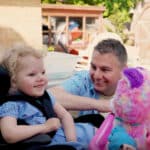She wheels herself in, presses the buttons and decides where she wants to be. That small level of independence has made a huge difference. She feels more connected to her home and has more control over her day.

My journey into occupational therapy began with personal experience. At the age of eleven, I had surgery to lengthen my Achilles tendon and spent months in rehabilitation. I was fascinated by the process – how movement, care and therapy could restore independence.
That interest shaped my career. After studying sports therapy alongside my A Levels, I completed a BSc in Occupational Therapy at university. During a placement, I found real purpose in supporting families to live safely and independently at home. I’ve since worked in the field for several years and completed a master’s in Healthcare, Law and Ethics at Swansea University.
Our daughter Bonnie is five and has Spina Bifida, specifically Myelomeningocele. She’s a wheelchair user and a cheerful little girl who attends a local mainstream school, where she receives brilliant support.
Bonnie was born in November and was transferred straight into neonatal intensive care at the Children’s Hospital for Wales. We were able to bring her home just before Christmas, which was incredibly special for all of us.
While in the hospital, Bonnie underwent a major back closure operation, followed by a second procedure to fit a shunt after developing hydrocephalus. She is paralysed from the waist down, has one kidney, and experiences a range of visual and hearing challenges.
In those early months, Bonnie had no head control and an open wound on her back. Moving her safely was extremely difficult. We also needed specialist equipment, which was heavy and had to be carried up and down the stairs every day.
We were fortunate to have support from my mother-in-law, but she struggled with the stairs herself. Carrying Bonnie simply wasn’t safe. We lived with a constant fear of falls.
We knew we couldn’t carry on like that.
Like many families, our first thought was a stairlift. But lifting Bonnie on and off would have become harder as she grew. Our stairs are long, curved and narrow. It would have been uncomfortable for her and not especially safe.
Because of my background, I was familiar with homelifts and began to explore what was available. Although I do work with Stiltz, I made sure to consider a range of manufacturers to remain completely objective.
The whole process took nearly three years, involving grant applications, redesigning part of the house and working with various departments at the local council.
We had several companies assess our home, but due to its freestanding design, Stiltz was the only option that could be placed exactly where we needed it.
The Stiltz team worked closely with our architect to agree on the lift design and location.
The plans showed the lift travelling from the hallway to a spare bedroom and were submitted as part of a Disabled Facilities Grant application, which was approved.
There were further hurdles. Walls had to be removed, RSJs installed, and we relied on input from Stiltz structural engineers to get everything signed off. Once the building work was complete, the installation took just a couple of days.
Bonnie’s grandmother can now look after her safely and get her upstairs to bed using the lift. It means my wife and I can go out for the evening, knowing Bonnie is in good hands and safe.
Her older brother gets involved too. He helps her into the lift and rides up with her. Bonnie loves it. She wheels herself in, presses the buttons and decides where she wants to be.
That small level of independence has made a huge difference. She feels more connected to her home and has more control over her day.
There are practical benefits, of course, but the emotional impact is harder to describe. We feel more connected as a family and can enjoy everyday moments again without stress or fear.
Professionally, yes. Many people assume stairlifts are the obvious choice, but they don’t always consider the practical challenges. Getting on and off, carrying things with them, or feeling secure at the top of the stairs. Where possible, I always recommend considering a homelift.
Personally, I can’t recommend ours highly enough. It looks brilliant too, with its blue lighting, curved design and clear lift car. But far more importantly, it’s transformed the way we live.
She wheels herself in, presses the buttons and decides where she wants to be. That small level of independence has made a huge difference. She feels more connected to her home and has more control over her day.
